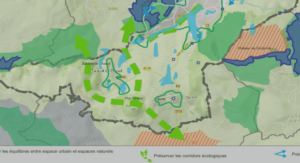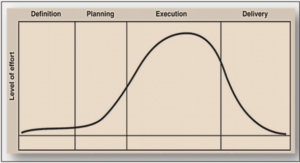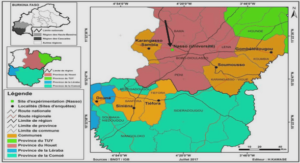Geologic setting of the Lesser Antilles Island arc
Two hypotheses have been proposed for the origin of the Caribbean plate. The first hypothesis suggests for the Caribbean plate a Pacific origin over the Galapagos hot-spot between 91 and 73 Ma (Duncan et al. 1984; Pindell et al. 2001), while the second favours its formation between the two American plates over several spreading centres (James 2006; Meschede et al. 1998). The Lesser Antilles Island arc, which results from the westward subduction of the Atlantic plate under the Caribbean plate, has been active since the Early Eocene, based on fossil evidence (Nagle et al. 1976). Southward of Martinique Island, volcanic activity has been almost continuous along the same arc line from the Oligocene to the present. Consequently, the oldest deposits are buried under Plio-Pleistocene volcanics (Fig. 1) and thus do not outcrop. Northward from Martinique, the Lesser Antilles island arc is double (Fink 1972; Martin-Kaye 1969), with the outer older arc to the north-east and the inner active arc to the north-west. The north-eastern branch, the so-called Limestone Caribbees, consists of lowlying islands without recent volcanic centres (Fig. 1), but volcanism may have been active there from Oligocene to Miocene (Briden et al. 1979), with apparent decreasing ages from north to south. After several million years of repose, volcanism resumed westward along the recent arc (Fig. 1), which is still active today.
The Limestone Caribbees
A limestone plateau that contains nannofossils of Pliocene age constitutes the islet of Sombrero (Bouysse et al. 1985; Fig. 1), whereas Dog islet’s basement is composed of altered volcanic deposits covered by Miocene limestones (Maury et al. 1990). On Anguilla Island (91 km2 ), black shales of upper Paleocene age are overlain by middle Eocene volcaniclastics and limestones of middle Miocene age (Maury et al. 1990). The basement of Saint Martin (100 km2 ) is composed of the Eocene Pointe Blanche formation, which is made of siliceous tuffs and calcareous intercalations (Maury et al. 1990). This formation has been intruded by basalts, andesites and quartz-diorites during the lower Oligocene (Nagle et al. 1976), and covered by limestones of upper Miocene age (Lowlands Formation; Maury et al. 1990). Saint Bartholomew (25 km2 ) is mainly composed of submarine volcanic products and calcareous horizons ascribed by Maury et al. (1990) to the middle Eocene, followed by a second volcanic cycle that may have occurred between 36 and 24 Ma (Briden et al. 1979; Maury et al. 1990; Nagle et al. 1976). Barbuda is a low-lying island (174 km2 ) composed of uplifted Pleistocene limestones (Maury et al. 1990). The volcanic basement of Antigua (280 km2 ), and the overlying unit made of volcanic conglomerates, have ages between 24 and 20 Ma with a surprisingly old age of 38 Ma (Briden et al. 1979; Nagle et al. 1976), but these former ages are suspect with respect to the uppermost limestones unit ascribed to the upper Oligocene (27 – 23 Ma; Maury et al. 1990). The island of Grande Terre (650 km2 ) is completely buried by limestones, lying uncomfortably on weathered volcanic deposits (Bouysse et al. 1984; Maury et al. 1990). This Plio-Pleistocene carbonate platform is the thickest (120 m) and the most complete sequence of the Lesser Antilles (Léticée et al. 2005). The island of Marie Galante (150 km2 ) is a limestone table of Plio-Pleistocene age, tilted to the southwest due to recent normal faulting (Feuillet et al. 2002), and La Désirade (30 km2 ) has an igneous basement of Eocene age, capped by Pliocene limestones (Maury et al. 1990).
Martinique Island
The eastern (La Caravelle) and south-eastern (Sainte Anne) peninsulas of Martinique Island (Fig. 1) are remnants of the Basal Complex (BC) and Sainte Anne Series (SAS) volcanic units (Fig. 2), of Oligocene and Miocene ages, respectively (Andreieff et al. 1988; Grunevald 1965; Westercamp 1972; Westercamp et al. 1980, 1989). These lava flows and volcanic centres, interbedded with sedimentary deposits, were emplaced during the activity of the Older Arc. In order to propose a chronology for these deposits, Andreieff et al. (1988) used the biostratigraphic timescale of Berggren et al. (1985), which is based on the recognition of fossils determined in the Caribbean area. A small bioclastic limestone deposit (referred as “g3” by Westercamp et al., 1989, Fig. 2a) located at the western end of La Caravelle peninsula directly overlays the Basal Complex at Morne Castagne. It has been determined as Late Chattian (Shallow Benthic zone SBZ23), in Late Oligocene, due to the presence of benthic foraminifera (Miogypsinoides complanatus and Miogypsina panamensis; Andreieff et al. 1988; Westercamp et al. 1989). Then, reef limestones (referred as “m1a” by Westercamp et al., 1989) with Miogypsina panamensis, Cyphus, Heterostegina antillea and Lepidocyclina canellei have been deposited during the Early Aquitanian, and are characterized by the absence of Miogypsinoides (Andreieff et al. 1988). These 50 m thick limestones outcrop directly over the BC at Pointe la Table (La Caravelle peninsula; Fig. 2A), and between the town Le Marin and Macabou (Sainte Anne Peninsula; Fig. 2B). Their similarity with “g3” limestones could indicate a continuous deposition during a maximum of 1 Myr across the Oligocene-Miocene boundary (Westercamp et al. 1989). In continuity with the “m1a” limestones, the limestones “m1b” record the unrest of volcanic activity with the deposition of volcanic ash and debris into deposit areas located to the north of Sainte Anne peninsula, between Le Marin and Macabou. Their lower part, called Macabou’s tuffites, contain some benthic (L. canelli, M. panamensis, H. antillea, “Operculinoides” panamensis, Spiroclypeus bullrooki) and planctonic (Globorotalia kugleri, G. mayeri, Globigerinoides primordius, G. immaturus) foraminifera, which yield an Aquitanian age (upper Zone N4, Westercamp et al. 1989). A stratigraphic section at Morne Carrière (Fig.2B) shows that these tuffites are overlain by limestones, also referred as “m1b”, which are characterized by the same fauna, except the extinction of Spiroclypeus, the appearance of Lepidocclina undosa, and the presence of evolved Miogypsines (Westercamp et al. 1989). This stage “m1b” is accompanied by the eruption of Sainte Anne Series products, which starts with subaquatic basaltic tuff, followed by the emplacement of small basaltic to andesitic strombolian cones and lava flows, and which ends with dacitic intrusions (Westercamp et al. 1989). Finally, reef limestones (referred as “m1c” by Westercamp et al. 1989) overlie Morne Carrière limestones “m1b” and SAS products to the south of the city of Sainte Anne (Fig.2B). These “m1c” limestones do not have volcaniclastic debris, but contain a poor fauna, with some fragments of Miogypsina Antillea, Archaias angulatus, Miosorites americanus, Globigerinoides gr. Trilobus, “Operculinoides” cojimarensis, Globigerinoides bisphaericus and Globoquadrina altispira. This association of foraminifera with the Zone N7-N8 (Globigerinatella insieta) allowed Westercamp et al. (1989) to propose a Burdigalian age for the end of the SAS activity. Due to the weathering of volcanic deposits and the use of whole-rock material, no reliable radiometric age was previously available for BC and SAS lavas (Andreieff et al. 1988; Westercamp et al. 1989). Furthermore, the few radiometric ages obtained were in disagreement with biostratigraphic subdivisions based on the recovery of foraminifera, and were thus rejected by their authors (Westercamp et al. 1989). But, since the Oligocene and Aquitanian limestones overlie Basal Complex, and, since Sainte Anne Series volcanics outcrops as interbedded within Aquitanian and Burdigalian sedimentary deposits (“m1am1b”; Andreieff et al. 1988; Westercamp et al. 1989; Fig. 2), these authors attributed a Late Oligocene age to the BC, and a Late Aquitanian age to the SAS.



